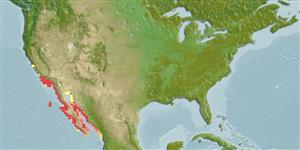Common names from other countries
>
Eupercaria/misc (Various families in series Eupercaria) >
Labridae (Wrasses)
Etymology: Semicossyphus: Greek, semi = half + Greek, kossyphos, -ou = a kind of fish (Ref. 45335).
More on author: Ayres.
Environment: milieu / climate zone / depth range / distribution range
Ekologi
marina revassocierade; djupintervall 0 - 55 m (Ref. 9311), usually 3 - 30 m (Ref. 9311). Subtropical; 37°N - 22°N, 123°W - 106°W
Eastern Pacific: Monterey Bay in California, USA to Guadalupe Island (off northern central Baja California) and Gulf of California.
Size / Vikt / Age
Maturity: Lm ? range ? - ? cm
Max length : 91.0 cm TL hane/ej könsbestämd; (Ref. 2850); publicerad maxvikt: 16.0 kg (Ref. 2850); rapporterad maxålder: 53 år (Ref. 56049)
Prefer rocky bottom, particularly in kelp beds. Often feed on hard-shelled organisms such as sea urchins, mollusks, lobsters and crabs. Spawning occur during the summer and the eggs are pelagic (Ref. 9311). Live to more than 50 years of age. Each individual functions first as a female but changes to a male at a length of about 30 cm. Pelagic spawners (Ref. 56049). Flesh is white, of good quality and marketed fresh (Ref. 9311). The large teeth can cause serious bite wounds.
A diandric species (Ref. 55367). Transforms to a male at length of about 30.1 cm TL and 7.9 years of age (Ref. 55367). Forms leks during breeding (Ref. 55367). Pelagic spawner (Ref. 56049).
Eschmeyer, W.N., E.S. Herald and H. Hammann, 1983. A field guide to Pacific coast fishes of North America. Boston (MA, USA): Houghton Mifflin Company. xii+336 p. (Ref. 2850)
IUCN Red List Status (Ref. 130435)
CITES (Ref. 128078)
Not Evaluated
Threat to humans
Traumatogenic (Ref. 13513)
Human uses
Fiskeri: kommersiell; sportfisk: ja; Akvarium: Kommersiell
Verktyg
Special reports
Download XML
Internet-källor
Estimates based on models
Preferred temperature (Ref.
115969): 16.6 - 22.9, mean 21.2 (based on 30 cells).
Phylogenetic diversity index (Ref.
82804): PD
50 = 0.6250 [Uniqueness, from 0.5 = low to 2.0 = high].
Bayesian length-weight: a=0.00955 (0.00456 - 0.02002), b=3.06 (2.89 - 3.23), in cm Total Length, based on LWR estimates for this (Sub)family-body shape (Ref.
93245).
Trofisk nivå (Ref.
69278): 3.6 ±0.43 se; based on food items.
Resiliens (Ref.
120179): Mycket låg, lägsta populationsfördubblingstid mer än 14 år (tmax=53; tm=5; Fec=300,000).
Fishing Vulnerability (Ref.
59153): Moderate to high vulnerability (55 of 100).
Climate Vulnerability (Ref.
125649): Very high vulnerability (78 of 100).
